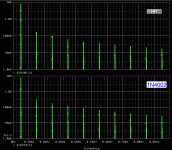The diodes will commutate near the zero-voltage crossing points of the voltage waveform. The heater current at that time is naturally approaching and nearly at zero. There will be some quite minor commutation related mains harmonics generated (due to the flat spot in the current waveform), but it is likely that the mains voltage waveform itself has naturally higher levels of harmonics.
But dissipating power in a semiconductor device is a lot higher risk than in a power resistor, as the diode junction is a lot more sensitive to transient temperature rise. During turn-on, heater current can get a lot higher than the continuous current rating, and it is all too easy to think a diode should handle that application, when the decision is really just a guess without doing some design assessment.
But dissipating power in a semiconductor device is a lot higher risk than in a power resistor, as the diode junction is a lot more sensitive to transient temperature rise. During turn-on, heater current can get a lot higher than the continuous current rating, and it is all too easy to think a diode should handle that application, when the decision is really just a guess without doing some design assessment.
The diode crap may be 30dB down. One odd thing is that it declines slowly with frequency. The most likely trouble path will be capacitive coupling into the amplifier, emphasizing the highs. So the buzz will extend well into the midrange.
A resistor dropper with an ideal source will have no nada zero zilch overtones. (SPICE figures -160dB which is numeric rounding.)
A resistor dropper with an ideal source will have no nada zero zilch overtones. (SPICE figures -160dB which is numeric rounding.)
Attachments
Thanks so much for this simulation! This is is such a great community with so much knowledge. I really enjoy understanding design decisions in depth, this simple thread about dropping a volt has been so enlightening!
If anyone is interested here is the audio simulation with and without a 100uF cap across the diodes. I used 100uF as I have a few of these laying around. I should probably invest in a few 1 Ohm resistors!
I did that using this, https://tinyurl.com/yzamw3v8
I did that using this, https://tinyurl.com/yzamw3v8
Attachments
If you're going to use an electrolytic cap, make sure it's bipolar or it won't be very happy... OTOH the voltage is very low so it might be alright.
Hehe that's an exceedingly good point! My stash of poly. capacitors top out at 10uF, so I guess a few DB more noise.
Perhaps make an actual measurement of the heater voltage or current, without diodes, to better appreciate all the harmonics and noise on your mains voltage. The point is not to miss seeing the wood from a tree or two.
But we can also use two polar caps in antiparallel! 😀If you're going to use an electrolytic cap, make sure it's bipolar
As trobbins is saying, 3% THD from diodes may be comparable to the THD straight from the power line. A uFd of capacitance will do little for a dynamic diode impedance near 0.1 Ohms; even 100uFd does little.
The resistor is simpler and cleaner, but may not be in your drawers like 1N4007.
The resistor is simpler and cleaner, but may not be in your drawers like 1N4007.
> sub the 1N4007 for an SB1100
Not likely any diode can "get rid of" the spikes. It turns off and on. That's not a smooth linear process. (The resistor is almost perfectly linear.)
Whatever this SB model is looks like 5dB lower. If it's in my drawers it is a contender. If I have to go to town to get some, maybe not worth it. The reduction may in part be the lower forward voltage drop. Which is counter-productive if we WANT voltage drop.
I find it hard to argue with a resistor. The only point of the diodes is that I may buy 100 all the same and have open bags of 87 diodes in abundance.
Not likely any diode can "get rid of" the spikes. It turns off and on. That's not a smooth linear process. (The resistor is almost perfectly linear.)
Whatever this SB model is looks like 5dB lower. If it's in my drawers it is a contender. If I have to go to town to get some, maybe not worth it. The reduction may in part be the lower forward voltage drop. Which is counter-productive if we WANT voltage drop.
I find it hard to argue with a resistor. The only point of the diodes is that I may buy 100 all the same and have open bags of 87 diodes in abundance.
Attachments
Last edited:
- Home
- Amplifiers
- Tubes / Valves
- Heater windings are giving me too much voltage!


